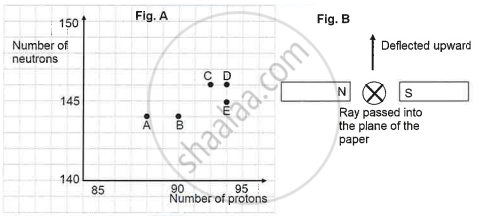Advertisements
Advertisements
Question
Describe the activity that shows that a current-carrying conductor experiences a force perpendicular to its length and the external magnetic field. How does Fleming’s left-hand rule help us to find the direction of the force acting on the current carrying conductor?
Solution
The activity is as follows:
Take a small aluminum rod AB. Using two connecting wires suspend it horizontally from a stand, as shown in the figure given below.

A current- carrying rod AB experiences a force perpendicularto its length and the magnetic field
Place a strong horseshoe magnet in such a way that the rod lies between the two poles with the magnetic field directed upwards. For this put the North Pole of the magnet vertically below and the South Pole vertically above the aluminium rod.
Connect the aluminium rod in series with a battery, a key and a rheostat.
Now pass a current through the aluminium rod from end B to end A.
It is observed that the rod gets displaced towards the left due to the force experienced by it.
Fleming’s left-hand rule is used to find the direction of the force acting on the current carrying conductor. According to this rule, stretch the thumb, forefinger and middle finger of your left hand such that they are mutually perpendicular as shown in the diagram. If the first finger points in the direction of magnetic field and the second finger in the direction of current, then the thumb will point in the direction of motion or the force acting on the conductor.

Fleming's left - hand rule
APPEARS IN
RELATED QUESTIONS
What concealed do you get from the observation that a current-carrying wire deflects a compass needle placed near it?
Name and state the rule to determine the direction of magnetic field around a straight current-carrying conductor.
A soft iron bar is inserted inside a current-carrying solenoid. The magnetic field inside the solenoid:
(a) will decrease
(b) will increase
(c) will become zero
(d) will remain the same
State Fleming's left-hand rule. Explain it with the help of labelled diagrams.
Which way does the wire in the diagram below tend to move?

What is the force on a current-carrying wire that is parallel to a magnetic field? Give reason for your answer.
State condition when magnitude of force on a current carrying conductor placed in a magnetic field is maximum?
State Fleming's left handle rule.
Which of the following factors affect the strength of force experience by current-carrying conduct in a uniform magnetic field?
|
The graph (fig A) illustrates the correlation between the number of protons (x-axis) and the number of neutrons (y-axis) for elements A, B, C, D, and E in the periodic table. These elements are denoted by the letters rather than their conventional symbols. When the element C, depicted in the graph, undergoes radioactive decay, it releases radioactive rays. When these rays are directed into the plane of the paper in the presence of a magnetic field, as indicated in the fig B, they experience deflection, causing them to move upwards.
|
Name the law used to identify the radioactive radiation emitted by the element.

